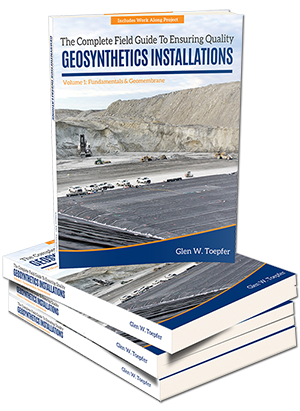Real estate agents will tell you that the top three considerations in their industry are: Location, location, location. Where the property is located is critical to its value. Well, the same goes for geosynthetics installations. The location of destructive samples is critical.
I received the following response to my It’s a Blessing and a Curse blog post (4/12/14). Boyd made his comments on LinkedIn, where I routinely feature my blog posts:
This topic and several other issues have been addressed most recently within GSI White Paper #26 : Need for and Justification of Quality Management Systems for Successful Geosynthetic Performance. Destructive sample frequency is also the focus of GRI GM14: Standard Guide for Selecting Variable Intervals for Taking Geomembrane Destructive Seam Samples Using the Method of Attributes and GRI-GM20 Standard Guide for Selecting Variable Intervals for Taking Geomembrane Destructive Seam Samples Using Control Charts.
All of these publications and others within the references address the same topic: the process and protocol of obtaining destructive samples is damaging to the geosynthetic systems and even when done properly, results in a geosynthetic system that is weaker and less effective. Clearly destructive samples are necessary; they are a key step in verifying the effectiveness of the welding process. However the frequency of sampling should reward “good welding” and penalize “poor welding” Of more importance is the location of the destructive samples. Everything that can be done to remove destructive sample location from with-in the geosynthetic system should be done: taking samples from runouts, anchor trenches and even from practice pads. Within the body of the installation, sample locations should be removed from critical areas; the toe of sloped areas, near panel connections, adjacent to penetrations, etc. Ideally the destructive samples will be taken at as low a frequency as possible, within flat areas of the installation where the impact of a hole in the liner can be minimized. Boyd Ramsey
I appreciate Boyd’s feedback and agree with much of what he says. One of the biggest challenges in this industry seems to be the adaptation of new procedures, and open discussion can certainly benefit all of us on these critical topics. In that regard, I am going to share my thoughts and experiences on a few of these points to further promote discussion of these topics.
Reducing the amount of penetrations in a geosynthetics containment system should be an industry-wide goal. I am familiar with both GRI GM-14, and GRI GM-20, but as a CQA subcontractor whose team performs CQA on projects throughout the United States, I rarely see either of these guidance documents used. The standard specification is the 1 sample per 500 feet of welding, most commonly based on machine and operator combinations in addition to meeting the 1/500 feet overall for the project. This can be quite limiting, especially on small projects.
For example, on a very successful large project, I was able to juggle the destructs between operator/machine combinations to increase frequency on those that had problems while reducing frequency on those with no problems. Sometimes the daily requirement would still be exceeded until the problems were fixed, but in the end we were very close to our 1/500 requirement (instead of being substantially higher like 1/350).
My experience is that many regulators start questioning destructive failures and look to see if the CQA personnel are actually doing anything about the failures other than simply tracking the failure (i.e. increased frequency when failures occur), and unfortunately there are quite a few instances where nothing is done but tracking. This may attribute to the lack of implementation of some of the more flexible guidance documents.
There needs to be a balance in the sampling program to allow flexibility in choosing sample locations as well. Far too many people interpret the 1/500 specification as meaning the sample must fall 500 feet from the previous sample, and they are marked out as such. This does an injustice to both CQA and the geosynthetics liner system itself. Likewise, if all samples are taken from the anchor trench, run-out, or other predetermined locations, it does the same injustice by not holding the installer accountable for their welding over the course of the entire seam. It does not take long for the installation crew to figure out destructs are only being taken in such areas. I have seen first hand where I start a project by taking samples in such locations, only to change them up later, and suddenly the failure rate jumps significantly. Then you are left wondering if you need to go back and take additional samples from earlier seaming activities, or it causes more holes to be cut in the liner because you did have to go back.
Another consideration to be weighed in sampling outside of the actual containment unit is the likelihood that the seam is uniformly constructed from end to end. A significant amount of variables are at play over the course of the seaming period between trial seams: weather (cloud cover, humidity, wind, temperature fluctuation, precipitation, etc.), machine components, stable power supply, the human component, etc. A passing anchor trench destruct does the system no good if the other end of the seam will fail when in use. I am a huge proponent of the installer cutting end coupons from each seam and testing them in the presence of CQA personnel as this can do a lot to increase the confidence in the seam quality – yet I rarely see this written into any specifications either.
My personal belief is that until we have a technology implemented that will accurately non-destructively evaluate the entire length of all seams, there needs to be a balance that lies somewhere between the typical 500’ spacing of destructive samples and the taking of all samples outside of the containment area.



